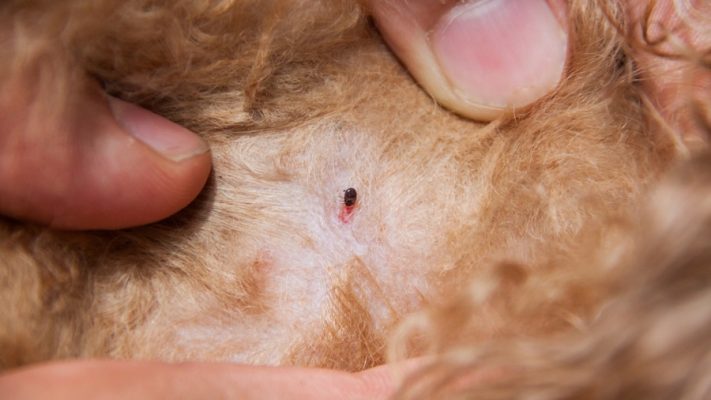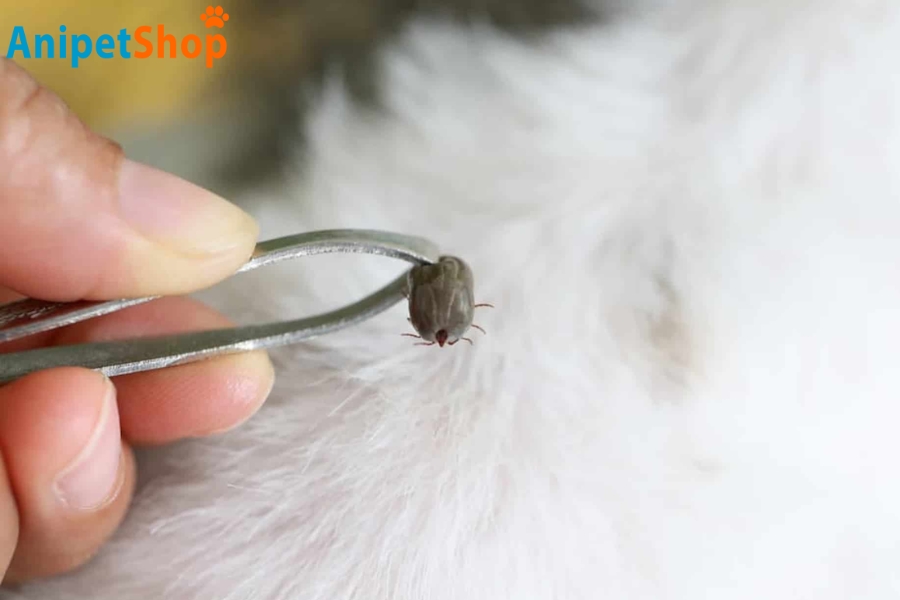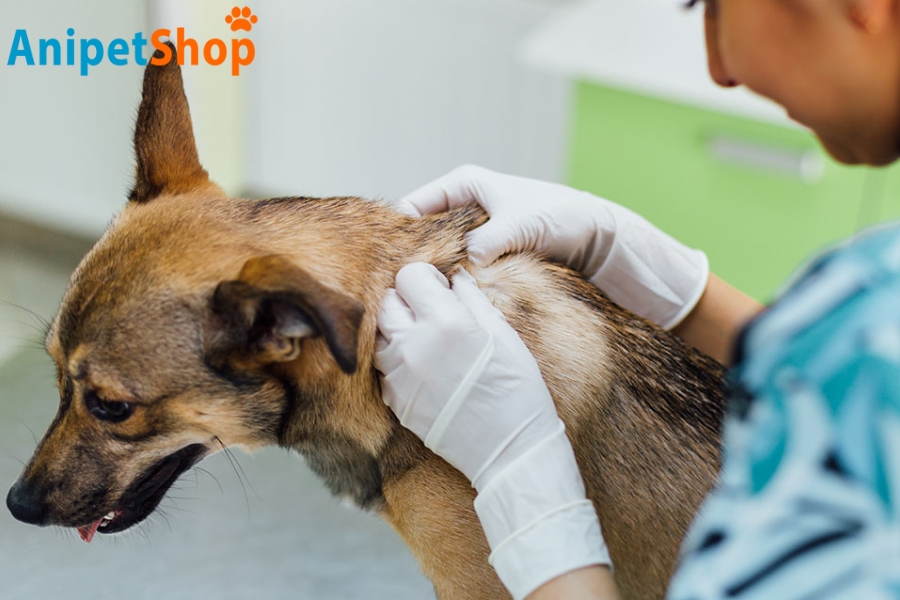Difference Between a Flea and a Tick
Do you find yourself worrying all the time about your dog’s continual scratching, wondering if it’s a flea or a possibly dangerous tick? To effectively treat and protect your beloved pet and home from these two parasites, you must be aware of their subtle differences. Although there are many difficulties associated with both fleas and ticks, understanding their distinctions is crucial for specialized prevention and removal tactics. This thorough guide seeks to provide you with the knowledge required to differentiate between these pests, guaranteeing the best possible protection for both your home and your beloved friend.

How They Look and How They Move?
Flea and tick are generally quite similar, however, they have many outstanding differences that help dog owners distinguish clearly.
Appearance
Fleas usually have the appearance of little, dark, reddish-brown spots, with a length of only one to two millimeters (same size with sesame seed). On the other hand, ticks come in a wide range of sizes, from tiny nymphs to bigger adult forms that can grow to a length of several millimeters or even centimeters when engorged with blood.

A flea on dog
In terms of color, ticks can range in color from brown to gray or even translucent, depending on the species and life stage, whereas fleas tend to be darker, ranging from reddish-brown to nearly black. However, a variety of factors, including age, climate, and feeding patterns, can affect the color of both fleas and ticks. Furthermore, after feeding on blood, fleas may look lighter, while ticks may appear darker when engorged with blood. As such, color alone may not always be sufficient to distinguish these pests; instead, a more thorough analysis of their size, form, and behavior is required.

A tick in adult form
The following table will give you vivid comparison between them:
|
Feature |
Flea |
Tick |
| Size | Little, as a sesame seed | Wide range of sizes (from tiny nymphs to bigger adult forms) |
| Shape | Flattened side-to-side | Oval with a distinct head |
| Color | Darker, ranging from reddish-brown to nearly black | Brown to gray or even translucent, depending on the species and life stage |
Movement
Fleas are adept jumpers, equipped with powerful hind legs designed for leaping onto their host’s fur with remarkable precision. Once on a dog, they become elusive due to their agility and speed, making them challenging to catch or remove manually.
Ticks, on the other hand, are sluggish crawlers, relying on an ambush strategy to latch onto passing hosts such as dogs or even humans. They often lie in wait amidst grass and brush, patiently waiting to attach themselves to a suitable host for feeding.
Where Can You Find Them?
The neck, ears, groin, and armpits are great real estate for fleas since they typically seek shelter in warm, damp locations. But they are also opportunistic and can live anywhere on the body where there is hair, especially in locations where the fur is dense or matted. They are difficult to identify because of their small size and agility, which allow them to move skillfully beneath the fur. On the other hand, ticks are frequently discovered hiding in outdoor settings like grassy or forested places, where they patiently wait to attach themselves to passing hosts. Ticks usually seek out regions with thinner skin, like the head, neck, ears, and spaces between the toes, while they are hitching a ride.

Tick or flea can be found in neck
However, they can also hide in less obvious places, such as under the tail or in the area around the eyelids. It’s critical to conduct thorough and frequent checks of these preferred hiding places, particularly following outdoor adventures, in order to quickly identify and eliminate any unwanted guests before they might endanger your dog’s health.
What They Eat & How They Bite?
Armed with specific mouthparts meant to puncture skin and draw blood, fleas are bloodsuckers. In addition to causing instant agony, their bites can irritate dogs’ skin and cause severe itching and inflammation. In addition, certain dogs may experience severe allergic reactions to flea saliva, which, if infestations are not controlled, could lead to dermatitis or even anemia.

Ticks, on the other hand, use a different strategy, putting their mouthpieces, or “hypostome,” under the skin of their hosts in order to suck on blood. It’s amazing how painless tick bites may be and how long they can remain undetected, giving these parasites hours or even days to feed. The extended feeding period that ticks experience, however, increases the danger of disease transmission because ticks can carry a wide range of diseases, including as bacteria, viruses, and parasites, which they can pass on to their hosts. This emphasizes how crucial it is to remove ticks quickly and to be vigilant in tick-prone regions in order to reduce the risk of tick-borne infections in both humans and dogs.

Impact on Dog Health & Home
Both fleas and ticks are harmful species not only to dog health but also to people living near that furry friend.
Impacts on Dog
When dogs are bitten by fleas, they can face up with many serious health problems. Here are three most common ones:
- Severe infestations can cause a great deal of discomfort and distress, and they are especially common in puppies.
- Flea Allergy Dermatitis (FAD) is a common allergic reaction to flea saliva, causing intense itching and skin irritation.

Flea Allergy Dermatitis
- Fleas can transmit tapeworms and various diseases, posing additional health risks to dogs.
Similar to fleas, ticks will also be such a harmful object on dog health.
- Ticks are commonly believed to be carriers of dangerous illnesses such anaplasmosis, ehrlichiosis, and Lyme disease. It is also observed that the prevalence of certain diseases varies with geographic location.
- Tick bites can result in localized inflammation and discomfort, and if left untreated, may become infected.
- Ticks’ extended feeding period raises the possibility of disease transmission, making it crucial to identify and remove them as soon as possible to safeguard dogs’ health.
Home Impact
If left untreated, flea infestations can spread throughout your entire home, necessitating thorough and expensive removal procedures. In a similar vein, ticks that lurk in your yard pose a constant risk to people and pets, underscoring the significance of routine yard care and pest avoidance techniques.
Treatment and Prevention
Whenever you look for methods to treat a flea or tick bite on your pets, it’s essential to prioritize veterinary guidance, particularly in cases of infestation. Veterinarians are qualified to determine the extent of the infestation and may suggest the safest and most efficient course of action based on your dog’s specific requirements, guaranteeing both efficacy and safety.

Always consult Vets
Furthermore, they can offer guidance on prophylactic actions, stressing the significance of continuous prevention to sustain steady defense against these parasites. Have a proactive discussion with your veterinarian about the best flea and tick prevention strategy in order to protect your pet’s health. By exploring the range of safe and effective preventive options available, you can take proactive steps to shield your beloved companion from the distress and health risks associated with flea and tick infestations.
FAQs
1. What is Worse for Dogs, Ticks or Fleas?
Both ticks and fleas pose significant risks to dogs. While fleas can irritate skin, create discomfort, and spread diseases like tapeworms, ticks are known to spread deadly illnesses like Lyme disease. To protect a dog’s health, both require immediate attention and preventative actions.
2. Can Fleas Live in Human Hair?
Yes, fleas can infest human hair, although they typically prefer to live on pets. When fleas cannot stay in dogs, they may settle in human hair and search for additional warm-blooded hosts, such as people. Nonetheless, flea infestations in human hair are less prevalent than infestations in pets, and humans are not their preferred host.
3. Can Fleas Get on Humans?
Yes, fleas can indeed get on humans. They may attack people if other hosts aren’t available, even though they prefer to feed on the blood of animals like cats and dogs. Humans can contract flea bites via pets or contaminated surfaces like carpets, bedding, or outdoor spaces.
4. How do I Know if It’s a Tick?
You can base on the shape, size and outside characteristics of species. Ticks are small arachnids with eight legs and oval-shaped bodies. They can vary in size and color, appearing brown, reddish-brown, or black. Ticks embed their mouthparts into the skin when feeding, resembling small bumps or warts. If you find a suspicious bump, carefully inspect it for these characteristics.
Once and for all, knowing the distinctions between fleas and ticks is essential to protecting our cherished dogs’ health and wellbeing. Given the possible health risks associated with these parasites, it is imperative for dog owners to maintain a high level of vigilance and education regarding preventative and treatment techniques. We can help keep our pets safe and healthy by being proactive in protecting them from ticks and fleas. Some of these proactive tactics include utilizing preventative items prescribed by veterinarians and scheduling routine veterinary checkups. Let’s arm ourselves with the information and tools needed to protect our animal companions against these bothersome pests. And whenever you need to buy high quality products and supplements for your furry friends, Anipet Shop is always about to bring you the greatest options.
Lily Watson is an author specializing in veterinary care in Australia. With a profound passion for animal welfare and a solid foundation in veterinary science, Lily has dedicated herself to disseminating valuable knowledge and information for both pet owners and professionals in this field.

